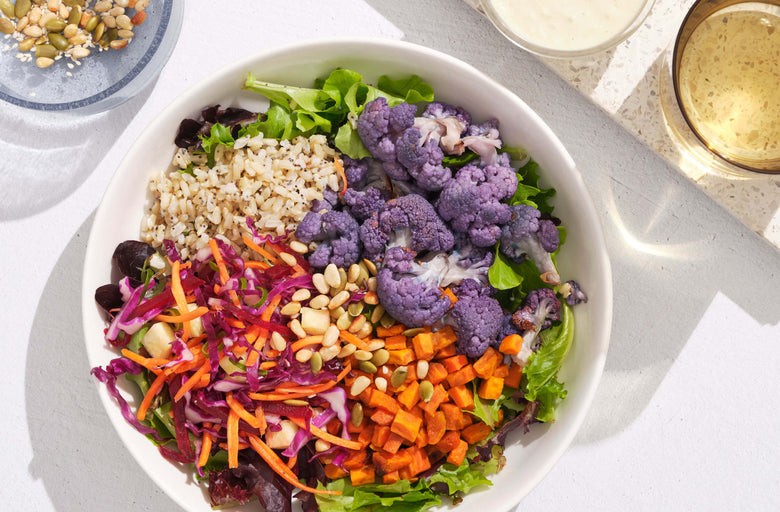Rich in warmth and vibrancy, spices embody the infinite power of plants—not only adding a kaleidoscope of colors and flavors to meals, but layering body, mind, and spiritual nourishment into our rituals for centuries.
Simple acts of communing with spice—whether through taste, smell, or touch—can trigger endorphins, dopamine, and feelings of bliss. Spices also have a thermogenic effect (giving your metabolism a nudge by fueling and revving it’s most essential reactions), and have been touted for their complexion-enhancing capabilities (evoking the ever-coveted post-coital glow).
We’ve rounded up the history and health benefits behind seven of our favorite spices. Dig in—and let these tips serve as a tantalizing reminder that “spicing things up” isn’t just about what goes down in the bedroom.
Black Pepper
One of the earliest known spices, this dinner table staple was first cultivated in India thousands of years ago, and soon after became essential to Ancient Indian and Chinese medicines. Its ability to heal and balance—from stovetop recipes to medicinal treatments—continues to make it a must-have.
In Ayurveda, black pepper boasts multifaceted healing properties—strengthening the Pitta dosha (which controls digestion, metabolism, and energy); supporting the body’s cleansing processes; and, thanks to the alkaloid piperine, enhancing the bioavailability of other Ayurvedic herbs. And speaking of piperine: it also helps rid the body of bloat—stimulating digestive enzymes and reducing the time it takes for food to pass through the gastrointestinal tract (just a few reasons it plays a key role in our award-winning Metabolism Super Powder).
Try it, Sakara style: Grounding, Metabolism-Revving Elixir
Cayenne
Believed to have originated in Cayenne, French Guiana, this vibrant orange-to-deep-red pepper makes for a tantalizing spice that really brings the heat. A tiny sprinkle can kick up a smoothie, zhuzh up a soup, or transform hot cocoa into a healing (and divine) treat.
As a natural antihistamine, cayenne helps rid the body of congestion and cold symptoms. (Its power and potency is derived from capsaicin, the compound that makes spicy things, well, spicy.) Cayenne does more than dance with your tastebuds, though; it stimulates circulation and blood flow everywhere, tones down inflammation, and boosts your metabolism.
Try it, Sakara style: Fired-Up Chocolate Mousse
Cinnamon
It’s rich, it’s warming, it’s aromatic… and just a dash can up the nutritional profile of an entire dish. With its spice rack reputation as an aphrodisiac, anti-bacterial, and anti-inflammatory, cinnamon is clearly a multi-talented spice. (And long-established, too. In Ancient Egypt, cinnamon was viewed as more valuable than gold.)
Like cayenne, cinnamon works to rid the body of cold and flu symptoms, helping decongest by clearing mucus and warming the body from the inside out. The revered spice is also rich in antioxidants like polyphenols and flavonoids, which fight free radicals, help repair our DNA, and maintain the health of cells.
A note: Not all cinnamon is created equal. Search for Cinnamomum verum—commonly seen on the shelves as “Ceylon Cinnamon”—to reap the most body-loving benefits.
Try it, Sakara style: Autumnal Waffles with Stewed Apples
Cumin
With its slightly sweet, slightly nutty notes, cumin is considered an international cooking essential—and is especially prevalent in Indian, Arabic, and Mexican cuisines. This deep yellow-brownish spice adds a burst of flavor and a warming dose of plant medicine, helping soothe digestion and relieve congestion. Cumin also contains riboflavin, vitamin B6, and niacin—essential micronutrients involved in energy metabolism, proper brain function, and keeping your hair, skin, and nails healthy.
In Ayurvedic medicine, cumin is used to balance both the vata dosha (air and ether qualities) and kapha dosha (water and earth), and, when combined with coriander and fennel into Ayurveda’s “miracle tea,” works to invigorate the lymphatic system.
The lesser-known but potentially-more-potent black cumin, in seed or oil form, has also been studied and praised for its bodily blessings—from easing inflammation to fending off unhealthy bacteria and restoring digestive peace.
Try it, Sakara style: Cauliflower with Coconut Yogurt and Pomegranate
Ginger
Stomach-settling ginger has been implemented in Chinese, Indian, and Japanese modalities for thousands of years, treating internal upset, indigestion, and nausea. Consumed in a myriad of forms—fresh, ground, pickled, preserved, crystallized, candied—ginger delivers a zesty, bright note to dishes around the globe.
Its standing as food-as-medicine is well-documented: research establishes ginger as a safe and effective tool to manage the physical manifestations of pregnancy (ie. morning sickness) and, for some, the side-effects of chemotherapy. Accumulating in the gastrointestinal tract, ginger stimulates the production of digestive acids, which then helps enhance nutrient absorption, ease bloat, and quiet reflexes—ultimately aiding in alleviating nausea.
Try it, Sakara style: Turmeric-Carrot-Ginger Soup
Paprika
This soul-warming spice—rich in flavor and vitamin C—works to brighten, firm, and even your skin tone, fighting free radicals and blocking them from breaking down the skin’s collagen. Paprika also contains capsaicin—the same compound that gives spices like chili powder and cayenne their beloved kick—increasing digestive fluids in the stomach, and supporting other more sultry benefits all over (think: optimized blood flow and a livened libido).
Its sweet-meets-savory flavor is a staple in Spanish and Hungarian recipes. (It’s so beloved in fact, it’s the national spice of Hungary.) With a mildly peppery zing, this versatile addition graces meals from dawn to dusk. Dust on soups, salads, or roasted vegetables… or elevate it to VIP dinner guest status via this decadent paprika and tahini ranch.
Try it, Sakara style: Pan Roasted Mushrooms with Smoky Red Pepper Tahini
Turmeric
In Sanskrit, this brilliantly colored spice has at least 53 different names, including “ratrimanika” (as beautiful as moonlight); “jayanti” (one that wins over diseases); and “bhadra” (auspicious or lucky). You might know turmeric as an earthy, slightly bitter essential of your feel-good spice repertoire—for good reason, since it adds vibrancy and vitality to every plate.
The spice’s great healing powers (and famous golden tint) can be credited to its main active compound, curcumin. Curcumin helps soothe system-wide inflammation, as well as boost levels of brain-derived neurotrophic factor, or BDNF—a hormone in the brain that supports healthy cognition and a sharper, brighter memory.
Try it, Sakara style: Turmeric Kale Fried Rice
A few final spice notes? Always choose organic, and store containers in a dark cabinet away from sunlight and heat (and not over your stove top to maximize flavor, potency, and benefits in the kitchen, bedroom, and beyond.)
Stay spicy, Sakaralites.






